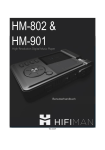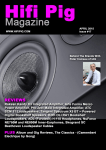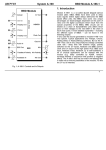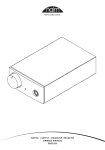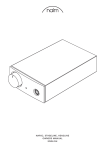Download Audiolab 8200CDQ Specifications
Transcript
Audiolab 8200CDQ CD Player with Built-In Preamplifier Written by Brian Alvarez Monday, 30 May 2011 00:00 Introduction to Audiolab 8200CDQ CD Player Early adopters live in a world of potential. We latch on to a new paradigm shift significantly ahead of the adoption curve. As such, we’re often saddled with legacy methodology or products. Solutions are never simple or straight forward. We push ahead and often have to improvise. Eventually the mass marketplace catches up and products appear addressing our needs. Audiolab markets a CD player called the 8200CD. THe 8200CDQ, reviewed here, also contains a built-in preamplifier that can deliver 4 volts RMS through its fully balanced outputs. This eliminates signal loss in cables that would normally connect a CD player's outputs to the preamplifier. Having used either a computer or music streamer for the past 8 years, I’ve waited for the ancillary components to catch up. I’ve had fantastic sounding products that never fully exploited the fundamental functionality of using a music server. I was forced to kludge together multiple boxes to achieve my desired outcome. I’ve yearned for the elegant solution of computer, DAC, powered speakers. Only recently have products come to market that fully exploit the power and flexibility of computer/streamer based systems. We’re at the tipping point and manufacturer’s such as Audiolab are responding accordingly. The CD player is dying off and I doubt it will get the resurgence Vinyl enjoys. The future is clearly digital downloads. For the moment in lossy compression, soon enough in lossless and eventually high resolution. Not everyone is ready to abandon their silver discs. It makes sense for Audiolab to offer a transitional product like the 8200CDQ. Described by Audiolab as a DAC with an integrated CD transport. It bridges the gap between the needs of those still using CDs as their main format, and giving these individuals a way to play their digital music files through the digital outputs of music streamers as well. The 8200CDQ is truly a landmark product, one which I’ve personally waited for quite some time. A top tier DAC with multiple inputs (including USB), an analog pre-amp with home theater bypass functionality, and a headphone amplifier, lest I forget a CD transport thrown in. Specifications Design: CD Player with Preamplifier Digital Inputs: Two Optical, Two Coaxial, USB (Asynchronous) Analog Inputs: Three Single-Ended RCA inputs (All Configurable for HT Bypass) Digital Outputs: One Optical, One Coaxial Analog Outputs: RCA (Max 2 Volts RMS), XLR (Max 4 Volts RMS) Sample Rates Coaxial: Up to 24 bit/96 kHz (including 88.2khz) Sample Rates Optical : Up to 24 bit/96 kHz (including 88.2khz) Sample Rates USB: Up to 24 bit/96 kHz (including 88.2khz) DAC: 32-bit ESS9018 Sabre32 32-bit/84.672MHz Oversampled/Upsampled, 512 Element, Multi-bit Array DAC (Four DACs per Channel) ESS9018 Sabre32 1920x Oversampling with 44.1kHz Source from CD/USB High-current, Single-ended and Balanced, Discrete Class A Output Stage High-performance, Direct-coupled, Discrete Class A Headphone Amplifier Custom CD Servo Design – with Ultra-Low-Noise PSU for OPU 34 Regulated Power Supply Rails 14 Ultra-Low-Noise Discrete Regulators User-selectable Digital Filter Settings – Software Upgradeable via USB Port Master Clock Jitter Less than 3 psec Short Term Dimensions: 3" H x 17.5" W x 13.8" D MSRP: $1,399 USA Audiolab Design of the Audiolab 8200CDQ CD Player Audiolab has a long history in British hi-fi. I can recall wanting an 8000A integrated amp when I put together my first hi-fi system. Unfortunately for me it was out of my price range at the time. Founded in England in 1983, Audiolab was acquired in 1998 by Tag McLaren. Tag McLaren renamed the company to Tag McLaren audio and moved the entire brand upmarket. After shutting the doors in 2003, IAG acquired the brand and re-launched it as Audiolab. International Audio Group initially put into production the original 8000 series products. Recently IAG (which has a great roster of hi-fi companies under its belt, including Luxman) re-designed the entire product line and now we have the 8200CDQ which belongs to the all new 8200 series components. The design of the 8200CDQ was headed by John Westlake and Dominik Peklo. John Westlake has a long history designing ground breaking digital playback products. He is responsible for the original DacMagic, the legendary Pink Triangle DaCapo (still viewed by some as one of the best digital playback systems), and the DAC section of the Peachtree Nova. I opted to get the silver finish, black is also available. Build quality is above par with components in this price range. The entire chassis is very rigid, buttons have a pleasant amount of resistance and have a positive engagement. Connectors are securely mounted to the back panel as well. Internal build quality is considerably better than most products of this type and price. A particular stand out is the quality of the remote. Most remotes for hi-fi equipment are off the shelf units. What we have in the 8200CDQ is the Audi interior of remotes. Logically laid out, good ergonomics, positive engagement of buttons, and a great feel. The underside of the remote is painted in black soft touch paint. The soft touch finish provides a good non-slip surface and a very pleasing feel. The top panel of the remote is made of brushed aluminum, very similar in color and finish to the front panel of the player itself. IR reception is exceptional, with incredible off axis performance and range. The CD tray is slim, fairly rigid and operates very quietly. The CD section does not support SACD (which is an issue for you classical music fans out there), but it does support CD-Text. The transport section is slaved to the clock of the DAC which helps to reduce transport induced jitter. Opening up the player, the sheer number of capacitors is amazing, as is the number if regulated power supplies and regulators. That said, I’m not one to believe that more of X equals better sound. Engineers/designers all have their unique philosophies to making good sounding gear. We often get caught up that X is a panacea for great sound. I prefer to let my ears be the judge and not buy into it, still...I appreciate ridiculous build quality like this. John and Dominik have also implemented several digital filters including three that offer zero pre-ringing. Zero pre-ringing filters address one of the main problems with digital audio low pass filters. They introduce “ringing” before the attack of an impulse. These types of filters are usually not found on equipment anywhere near this price range. Though recently this has changed with the new Rega DAC having a similar filter. The filter algorithms used in the Audiolab have been written from the ground up by John and Dominik. Audiolab 8200CDQ CD Player Setup There are so many features on the 8200CDQ it’s best to address them by function. I’ll break the review into the following sections; CD/DAC (digital pre-amp), Analog Pre-Amp, Headphone amp, and the remote. The digital section of the CDQ encompasses the CD transport and digital inputs, with the DAC (using selectable filters) driving the single ended RCA and balanced XLR outputs. There’s also a pair of digital outputs, one coax, one optical (analog signals are not passed through to the digital outputs). You have the option to use the CDQ as either an all digital pre-amp or an analog one. The signal sent to the XLR and RCA outputs (only one should be used at a time) can be attenuated in either the analog or digital domain. This is true for either the CD, or digital inputs, analog inputs remain analog the entire way and must use the analog volume control. In the past, the obvious choice was to use the analog volume control to preserve the resolution of the digital signal. This is was due to old digital volume controls utilizing truncation. In the CDQ, a dithered digital volume control combined with noise shaping actually outperforms the analog volume control. There are distinct advantages to using a properly implemented digital volume control. A digital volume control in most cases offers better left to right channel linearity at low volumes, better channel separation and finer control over volume. If you do choose to use the analog volume control, the DAC output is routed via relays to the analog volume control. From my own listening sessions (especially with active studio monitors) the digital pre-amp won out for transparency, and resolution. The analog volume control is not far behind. You just can’t switch in additional circuitry without some effect. Considering how much cleaner the signal path is with the digital pre-amp, I doubt many people would prefer the analog route. The selection of digital inputs is accomplished by pressing one of two input selection buttons which rotate through the 5 digital inputs. Two optical, two coaxial, one USB. It’s worth noting that the USB input supports 88.2khz which is quite rare in USB equipped DACs. When selecting a digital source, lock is immediate, and the display provides both word length and sample rate information. The display incidentally is small and doesn’t have sufficient contrast to be easily read from further than 6 feet. In CD mode the following set-up options are available; Preamp mode, Digital Filter (applies to all digital sources), CD-Text, and Display Brightness. Preamp mode allows you to select between digital or analog volume control. CD-Text, whether or not to show the artist and track information on discs with CD-Text data. Display brightness is fairly obvious. Digital filters, that’s where the magic of this player lies. It allows you to select from the seven available filter types which I’ll cover after explaining the DAC options. The filter types are; Sharp Rolloff, Slow Rolloff, Minimum Phase, Optimal Spectrum, Optimal Transient, Optimal Transient XD, Optimal Transient DD. The manual makes very little mention to the differences in sound quality or technical approach to each filter. More information would be welcome. DAC mode has several options: Preamp mode, Digital Filter, Digital Input PLL (Phase Locked Loop), Display Brightness, USB Audio Mode. The only different parameters from CD mode are the USB Audio Mode and Digital Input PLL. USB Audio allows you to select between 24/96 asynchronous mode and compatibility mode. Compatibility mode reverts the USB interface to adaptive operation. This should only be used if your computer set up does not function with asynchronous data transfer mode. The difference in sound quality is audible. Digital Input PLL is for the optical and coax connections only and sets the sensitivity to jitter from a source. Options are; low, medium, high, and auto. Digital Input PLL is adjusted for each specific input. Auto is default and most recommended if you don’t know the specific jitter levels of a source (according to the manual). High bandwidth offers the most tolerance of high jitter sources but does have some reduced performance. Low bandwidth is for low jitter sources, the lowest tolerance and also the best audible performance. Medium splits the difference. In theory using the low setting can cause pops or clicks with high jitter sources. In real world use I could hear audible differences between Low, Medium and High. Low offering the best detail and soundstage. I never once experience an audible pop or drop out using low with any of my sources. The analog input section has three inputs, all of which are completely handled in the analog domain. The three inputs are named, Tuner, Aux, and Video. Each input has a direct access button on the remote, but must be cycled through the use of the up and down buttons on the front panel. The single ended inputs are converted to true dual-differential balanced audio signals internally. The options per input are; Input Level Trim, Home Theater Mode, and Display Brightness. Input level trim is only available if the input is not in Home Theater bypass mode. The level of adjustment is +/-24db. Home Theater Mode is adjustable for each of the three inputs, it’s not likely to be used with more than one input, yet the flexibility is appreciated. The Display Brightness functions the same regardless of input. The Headphone amp operates in class A and sounds fantastic. There are no options to the headphone amp other than plugging in your desired set of cans. Inserting a 1/4” headphone cable to the input automatically mutes the main outputs. The volume remains the same when you plug in headphones as when listening to speakers. It would be nice if there could be two different volume settings to prevent over driving headphones, or the speakers when you unplug headphones. The remote control is especially good in both ergonomics and build quality. Buttons are very logically laid out, well spaced, with exceptionally good resistance when pressed. Two AAA batteries power the remote. The remote operates both the 8200CDQ and the matching 8200 series Tuner. Which unit is controlled is defined by pressing the mode button, a light at the top left corner indicates CD or Tuner selection.The remote has a mute button but there is no way to turn off the 8200CDQ from the remote. The only way to turn off the 8200CDQ is by pressing the front panel power button. Audiolab 8200CDQ CD Player In Use For my initial listening I hooked up my MacMini via USB to the 8200CDQ, an Apple TV via Toslink and a Sony Blu-Ray player via coaxial and also via analog to audition analog inputs. I split my time listening to the CDQ between a pair of JBL Pro LSR2325p active studio monitors, and a pair of Bowers and Wilkins CM8 speakers driven by a Myryad MI-120 integrated amp. Volume control was handled by the Myryad (the 8200CDQ was kept in digital pre-amp mode with the level set to digital 0) when using the CM8s. With the JBL monitors I used the digital volume control of the 8200CDQ. The best results I heard were using the XLR outputs. Since the internal signals for the 8200CDQ are dual differential balanced, the XLR outputs are noticeably quieter than the single ended outputs. Tonally and in terms of resolution both outputs sounded the same, minus the noise floor differences. Listening in the more traditional set up (B&W CM8 speakers, Myryad MI-120 integrated amp, the Audiolab’s volume control bypassed) was impressive. Even from dead cold the player is beautiful sounding. Removing the various analog gain stages and analog volume controls by going straight into a pair of active monitors was a revelation. The JBL LSR2325p is hardly a high end speaker. The JBLs amazingly flat frequency response, active crossovers and well matched amps all fell into a perfectly choreographed musical dance with the 8200CDQ. The pair may not be the last word in resolution (I achieved significantly better transparency with the B&Ws) but it surpasses so many combinations on pure listening pleasure. It’s a stunningly fun and musically engaging duo. The Audiolab 8200CDQ is a landmark product, I hesitate to use the word reference since I’ve not heard all the DACs available. In the context of the DACs I have owned and have heard; Benchmark DAC1 HDR, Bryston B100SST (with integral DAC), Naim SuperNait, Peachtree Nova. Well the Audioloab stands in a group of one. It’s a remarkable achievement. Clean, detailed, musically engaging, able to communicate emotion, it just sounds right. It serves massive amounts of detail and resolution without ever coming across as cold or thin. Bass has immense weight and speed, with exceptional pitch definition. The closest performer I’ve heard is the Benchmark DAC1 HDR. The 8200CDQ using the Optimal Spectrum filter sounds incredibly similar to the DAC1 HDR. Switch the Audiolab to one of the three Optimal Transient settings, and it’s game over. The Audiolab gains a level of musicality and attack that I’ve never experienced. There’s a dynamic realism in percussion that is breath taking, the attack of bass drums (real or synth based), the snap of drum sticks against the skin of snare enthrall you with a lifelike dynamic I’ve not heard before. One can hear the Attack, Sustain, Decay, Release as distinct elements of each note. The 82000CDQ lays bare the energy and dynamics of music, honestly and realistically. Bass drum kicks are so detailed, snares so vibrant, if you love percussion, this is the player/DAC for you. Voices are intimately communicated with every nuance. One can almost sense the distance from the microphone in millimeters from each singer. Every instrument, vocal, synth, beat, you name it, occupies a distinct place in 3 dimensional space, the dynamics of each never obscuring the other. Overly dynamically compressed music shines through the Optimal Transient filters. It’s as if you’re applying a reverse multi-band dynamics processor. Listening to albums I previously considered lifeless and overly compressed (on other dacs and on the Audiolab with the Optimal Spectrum filter) with the Optimal Transient filter, these albums became markedly more dynamic and musical. AAC and even MP3 files also sounded remarkably good. I found myself losing hours listening to RDIO streamed from my iPhone to an Apple TV 2 via AirPlay. The old adage holds true, crap in, crap out. Just to a much lesser extent with the 8200CDQ. AAC and even MP3 files could sound remarkably good at times. I often found myself getting lost for hours listening to RDIO streamed from my iPhone to an Apple TV 2 via AirPlay. So engaging was the musical performance that I was able to disregard the lossless compression and just enjoy myself. If you want an analytical unforgiving view into a recording switch back to the Optimal Spectrum filter. This will inevitably give you more resolution, a tad more extension in the treble and depth in the bass, and perhaps a shade more mid-range resolution. Do so if you have no soul and wish to measure everything you listen to with a teutonic level of efficiency. The passionate music listeners will never want to depart from Optimal Transient (in all three variants, each has a subtle difference). Fed 24/96 or 24/88.2 material, the Audiolab will delight and will have you wishing for more high resolution recordings. Still, playing 16/44.1 more than holds its own and other than resolution you give up nothing in enjoying this now ancient format. In comparing CD vs. DAC I was surprised by the results. First comparison was a CD against the ALAC file of the same track played back via either iTunes or PureMusic on a Mac. Sometimes I preferred PureMusic over iTunes, other times the opposite. Versus the CD I found any differences to be subtle and attributable to the USB cable being used. Don’t ask me why, in theory all USB cables should sound the same. They don’t. Using the Oyaide D+ Class A USB cable I could not reliably tell a difference between the original CD and the ALAC file. Through speakers it was impossible, using a pair of Denon AH-D2000 headphones via the class A headphone amp, a slight difference could be heard at times. Sometimes I preferred the CD, other times the USB input, more often I could not distinguish a difference. Out of curiosity I decided to burn the same ALAC files to an audio CD. I wasn’t expecting what I heard. In every single case, the CD made from the very same ALAC files sounded better. Better than both the original CD and the ALAC files played via USB or Toslink. The added dimensionality was palpable. Subtle details in the timbre of instruments were rendered more clearly from the CD-R. Odd indeed. If you’re after the truest listening experience I highly suggest this unorthodox method. as a DAC it’s safe to say the Audiolab equals the performance of the built in CD player if you compare the original CD to a lossless or uncompressed file from the same CD. I can go on and on citing examples of how the bass sounded on this recording, or the lucidity of the mid range with this vocalist on this album. It all sounds a bit cliché and it’s hard to quantify since I listened to so much music during my review period. Superlatives are in order but you’re better off with me sparing you how the hundreds of albums I listened to all sounded better than I’ve ever heard before. Otherwise this already lengthy review will turn into a novel. If you’ve primarily listened to CDs all your life, the Optimal Spectrum filter will initially sound the most correct. My guess is it would also measure the most accurately (Audiolab and John Westlake state this to be the case). You have to unlearn decades of pre-ringing digital filters to appreciate the Optimal Transient filters. Initially they sound a bit dark, recessed, with less energy and drive. Hang in there. The more you listen, the more you become re-educated. The organic textures and unbelievable snap to notes win you over. Best analogy I can think of is a Japanese sports suspension versus a German one. The Japanese sports car will tend to thrill you initially with a stiff ride, lack of body roll and no compliance. This sure feels sporty, but in the end the softer, longer travel, better damped German suspension equals the performance, if not surpasses it. All the while making your experience that much richer and rewarding. Yes, I do have a penchant for automotive analogies. One tip, the sound of the Audiolab 8200CDQ opens up and gains a noticeably relaxed quality when the display is turned off. Display off, optimal transient filter, digital volume control. There’s really no need for another configuration. Oh yes, the analog inputs sound remarkably clean and as transparent as can be expected. Equal in performance to the Benchmark DAC1 HDR and better than the analog section in my Myryad MI-120. The Bryston B-100SST wins out for analog transparency, then again it costs a substantial amount more than the Audiolab, and the Bryston’s DAC doesn’t sound nearly as good. Conclusions about the Audiolab 8200CDQ CD Player I spent nearly three months living with this player, listening to hundreds of hours of music. Never once did I regret purchasing this player/DAC. From day one, cold, no break-in this player just astonishes. It’s musical, detailed, fun and engaging to listen to. The flexibility of having analog inputs, home theater bypass, multiple digital inputs, a fantastic sounding USB input and a built in transport put it in a league of one at this price. It dethroned my beloved Benchmark DAC1 HDR. It even betters my previous CD reference, the amazing California Audio Labs CL-10. For those looking to streamline, pair the Audiolab with a set of good active speakers and be prepared to get lost in music. Compact, simple to use, and with a price to performance ratio unheard of before. Even when paired to speakers as modest as the JBL LSR2325p the resulting music is so engaging and entertaining. Moving up the chain to something like a Focal CMS50 or 65 will yield even more amazing results. It can also be used in a normal manner and also would be ideal with passive speakers and amp, minus the traditional pre-amp. Live with this player for a few days and you’ll fall in love. An audition is a must if you’re considering a DAC or a CD player anywhere between 800-2000 dollars. Don’t short change yourself. Take all the functionality into account, a very reasonable price, and I am willing to make the bold statement that this could very well be THE digital product of the moment. It’s that good!







